Castelo Branco | |
|---|---|
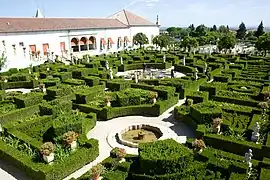 .jpg.webp) .jpg.webp)  %252C_2011._(5940230730)_(cropped).jpg.webp) .jpg.webp) Gardens of the Ancient Bishop's Palace, Agência do Banco de Portugal, View of Castelo Branco from the castle, Bishop Arch, Cross in the center, Convento da Graça | |
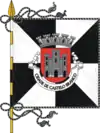 Flag  Coat of arms | |
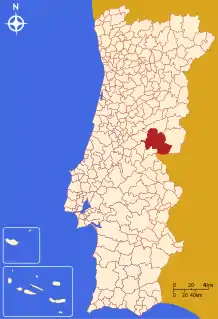 | |
| Coordinates: 39°49′N 7°30′W / 39.817°N 7.500°W | |
| Country | |
| Region | Centro |
| Intermunic. comm. | Beira Baixa |
| District | Castelo Branco |
| Parishes | 19 |
| Government | |
| • President | Leopoldo Rodrigues (PS) |
| Area | |
| • Total | 1,438.19 km2 (555.29 sq mi) |
| Population (2021) | |
| • Total | 52,291 |
| • Density | 36/km2 (94/sq mi) |
| Time zone | UTC±00:00 (WET) |
| • Summer (DST) | UTC+01:00 (WEST) |
| Website | http://www.cm-castelobranco.pt/ |
Castelo Branco (Portuguese pronunciation: [kɐʃˈtɛlu ˈβɾɐ̃ku] ⓘ) is an inland city and municipality in Central Portugal. It has 34,455 inhabitants in its urban area (2021)[1] and is the seat of the district of the same name. The municipality, with 52,272 inhabitants,[2] is made up of 19 freguesias (civil parishes) spread through 1,438.19 km2 (555.29 sq mi), making it the 3rd largest in Portugal by total land area.[3]
The municipality is bounded in the north by Fundão, in the east by Idanha-a-Nova, in the south by Spain, in the southwest by Vila Velha de Ródão, and in the west by Proença-a-Nova and Oleiros.
History
Castelo Branco gets its name from the prior existence of a Luso-Roman castrum or fortified settlement called Castra Leuca, on the summit of the hill of Colina da Cardosa. The population grew on the slopes of this hill.
Little is known of the history before 1182. There is, nevertheless, a document, from this date, mentioning the donation to the Templars of a piece of land called Vila Franca da Cardosa, by a noble Fernandes Sanches. In 1213 it received its autonomy or foral and the name Castel-Branco appears for the first time. Pope Innocent III confirmed this in 1215 giving it the name of Castelo Branco.
It was around this time that the Templar Knights built the walls and the castle.
In 1510 a new foral was conceded by Manuel I and in 1642 the town acquired the status of Vila de Castelo Branco.
In 1771 Castelo Branco became a city and a bishopric (see below) until 1881.
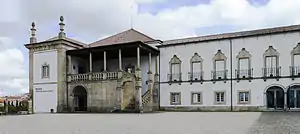
In 1858 a telegraph line was opened between Abrantes and Castelo Branco and in 1860 the city received its first public lighting.
In 1959 it became capital of the district of the same name.
Ecclesiastical History
Pope Clement XIV created the diocese of Castelo Branco on 1771-06-07.
On 1881-09-30 it was suppressed and its territory merged into the then Diocese of Portalegre, which adopted its title, becoming the present Diocese of Portalegre-Castelo Branco, and made the former Cathedral of Castelo Branco, dedicated to St. Michael the Archangel, its Co-cathedral.
It has had the following residential Bishops:[4]
- José de Jesus Maria Caetano, Dominican Order (O.P.) (1771 – death 1782-07-13)
- Vicente Ferreira da Rocha, O.P. (1782-12-16 – death 1814-08-25)
- Bishop-elect Patrício da Silva, Augustinian Order (O.E.S.A.) (1818 – 1819-05-03), later Metropolitan Archbishop of Évora (Portugal) ([1819-05-03] 1820-02-21 – 1826-03-13), created Cardinal-Priest with no Title assigned (1824-09-27 – 1840-01-03), promoted Patriarch of Lisboa (Portugal) (1826-03-13 – death 1840-01-03)
- Joaquim José de Miranda Coutinho (1819-05-03 – death 1831-04-06)
- Guilherme Henriques de Carvalho (1846 – death 1857-11-15), also Apostolic Administrator of Portalegre (Portugal) (1846 – 1857-11-15), created Cardinal-Priest of S. Maria sopra Minerva (1854-11-30 – 1857-11-15); previously Bishop of Leiria (Portugal) ([1840] 1843-04-03 – 1845-11-24), Patriarch of Lisboa (Portugal) (1845-11-24 – 1857-11-15)
Places of interest
The most important monument in Castelo Branco is the Jardim do Paço Episcopal (Garden of the Episcopal Palace). It is one of the most beautiful Baroque gardens in Portugal and contains statues of allegories, kings and zodiacal signs, arranged around ponds, terraces and staircases.
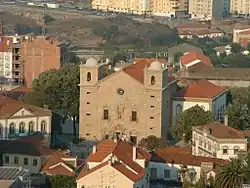 Co-cathedral St.Michael
Co-cathedral St.Michael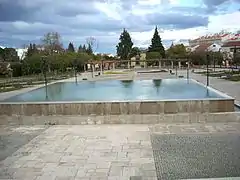 City's Park
City's Park City's Garden
City's Garden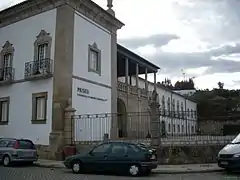 Museum "Francisco Tavares Proença Júnior"
Museum "Francisco Tavares Proença Júnior"
Civil Parishes
Administratively, the municipality is divided into 19 civil parishes (freguesias):[5]
- Alcains
- Almaceda
- Benquerenças
- Castelo Branco
- Cebolais de Cima e Retaxo
- Escalos de Baixo e Mata
- Escalos de Cima e Lousa
- Freixial do Campo e Juncal do Campo
- Lardosa
- Louriçal do Campo
- Malpica do Tejo
- Monforte da Beira
- Ninho do Açor e Sobral do Campo
- Póvoa de Rio de Moinhos e Cafede
- Salgueiro do Campo
- Santo André das Tojeiras
- São Vicente da Beira
- Sarzedas
- Tinalhas
Climate
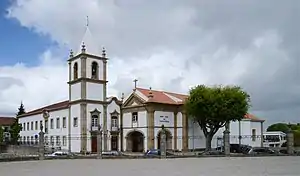
Castelo Branco has a hot-summer mediterranean climate.[6] Its summers are among the hottest of Portugal, influenced by its inland position. Winters are mild with cool nights, but frosts are rare and never severe. Inland areas further south in the country have hotter temperature extremes, although averages are very similar. There is somewhat of a seasonal lag in summer since September is significantly warmer than May in spite of less daylight. Winter temperatures are more consistent with the daylight cycle, since temperatures drop sharply in autumn months.
| Climate data for Castelo Branco, 1981-2010 normals and 1981-2022 extremes, altitude: 386 m (1,266 ft) | |||||||||||||
|---|---|---|---|---|---|---|---|---|---|---|---|---|---|
| Month | Jan | Feb | Mar | Apr | May | Jun | Jul | Aug | Sep | Oct | Nov | Dec | Year |
| Record high °C (°F) | 25.4 (77.7) |
22.3 (72.1) |
27.1 (80.8) |
30.0 (86.0) |
35.5 (95.9) |
40.0 (104.0) |
42.6 (108.7) |
41.6 (106.9) |
40.2 (104.4) |
32.5 (90.5) |
25.2 (77.4) |
20.1 (68.2) |
42.6 (108.7) |
| Mean daily maximum °C (°F) | 12.1 (53.8) |
14.0 (57.2) |
17.7 (63.9) |
18.7 (65.7) |
22.9 (73.2) |
28.3 (82.9) |
32.2 (90.0) |
31.9 (89.4) |
27.4 (81.3) |
21.0 (69.8) |
15.6 (60.1) |
12.4 (54.3) |
21.1 (70.0) |
| Daily mean °C (°F) | 8.1 (46.6) |
9.6 (49.3) |
12.6 (54.7) |
13.5 (56.3) |
17.2 (63.0) |
21.7 (71.1) |
24.9 (76.8) |
24.8 (76.6) |
21.4 (70.5) |
16.4 (61.5) |
11.7 (53.1) |
8.8 (47.8) |
15.8 (60.4) |
| Mean daily minimum °C (°F) | 4.1 (39.4) |
5.1 (41.2) |
7.3 (45.1) |
8.3 (46.9) |
11.4 (52.5) |
15.0 (59.0) |
17.6 (63.7) |
17.5 (63.5) |
15.3 (59.5) |
11.8 (53.2) |
7.6 (45.7) |
5.1 (41.2) |
10.5 (50.9) |
| Record low °C (°F) | −3.9 (25.0) |
−2.2 (28.0) |
−4.8 (23.4) |
0.4 (32.7) |
2.9 (37.2) |
7.3 (45.1) |
8.9 (48.0) |
10.0 (50.0) |
6.2 (43.2) |
3.4 (38.1) |
−2.4 (27.7) |
−3.4 (25.9) |
−4.8 (23.4) |
| Average precipitation mm (inches) | 101.0 (3.98) |
71.3 (2.81) |
55.3 (2.18) |
60.6 (2.39) |
53.7 (2.11) |
21.6 (0.85) |
8.3 (0.33) |
8.1 (0.32) |
39.8 (1.57) |
124.5 (4.90) |
114.9 (4.52) |
124.2 (4.89) |
783.3 (30.84) |
| Average relative humidity (%) | 80 | 73 | 61 | 62 | 59 | 49 | 41 | 43 | 53 | 69 | 78 | 83 | 63 |
| Mean monthly sunshine hours | 151.9 | 167.6 | 242.9 | 232.2 | 268.1 | 316.1 | 355.4 | 335.2 | 252.1 | 195.7 | 154.0 | 123.4 | 2,794.6 |
| Source 1: Instituto de Meteorologia[7] | |||||||||||||
| Source 2: Instituto de Meteorologia (sunshine hours)[8] (humidity)[9][10] | |||||||||||||
Economy
The city is home to Centauro, a company which produces industrial coolers, refrigerators and freezers. The Portuguese subsidiary of Danone has a factory in Castelo Branco which produces Danone's dairy products for the entire Iberian Peninsula. The district of Castelo Branco is also famed for the Castelo Branco cheese.
Delphi Packard is a major factory and the principal employer, with more than 1000 workers. The Factory makes automobile component for the most important automobile constructors like Ferrari.
Shopping malls in Castelo Branco (Alegro and Fórum)
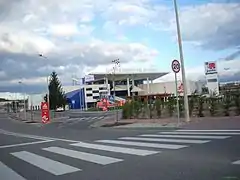 Alegro shopping mall (South view)
Alegro shopping mall (South view) Fórum shopping mall in Castelo Branco (East view)
Fórum shopping mall in Castelo Branco (East view) Fórum shopping mall in Castelo Branco city (North inside view)
Fórum shopping mall in Castelo Branco city (North inside view)
Education
Castelo Branco is home to the Instituto Politécnico de Castelo Branco, a state-run polytechnic institute of higher education, comprising schools of agriculture, technology, management, education, art and health.
Transportation
Railways: Castelo Branco is the principal station located some 100 kilometres (62 miles) up the Beira Baixa Railway Line from Entroncamento to Guarda. It runs via Abrantes, Rodão, Castelo Branco and Fundão with services currently terminating at Covilhã some 30 kilometres (19 miles) short of Guarda. Rail services are operated by CP - Comboios de Portugal (Portuguese Trains) and consist of three stopping trains (Regionais) and three fast trains (Intercidades) per day from Lisbon via Entroncamento. The fast trains take less than 3hours to reach Castelo Branco from Lisbon Santa Apolonia and Lisbon Oriente main stations. Stopping trains are considerably slower.
From Entroncamento, the route branches off the Lisbon to Porto main line onto the Beira Baixa line following the mighty Tagus river crossing it twice on impressively long bridges. From Abrantes a series of reservoirs come into view. For lengthy stretches the single track clings to the NW flanks of the reservoirs providing exhilarating forested views as you speed along the waterside. The services are operated by comfortable and purposeful 'Iberian Gauge' (5ft6in) 25 kV electric multiple units. After passing through some deep gorges into Rodao station the line then heads north away from the river and on to Castelo Branco and finally Covilhã.
From Covilhã northwards to Guarda trains were operated by more leisurely diesel motorcars. This scenic stretch of mountainous rural line provides the strategic last leg of the Beira Baixa Railway linking it to Guarda via Belmonte. However, in recent years it has been closed for modernisation and electrification. The partially completed works, originally due for completion in 2011, are sadly still on hold as of 2014 due to serious funding issues associated with the economy. This inconveniently cuts off otherwise direct rail options from Castelo Branco to destinations north of Covilhã.
Notable people
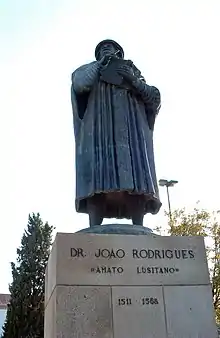

- Amatus Lusitanus (1511–1568), a physician, an early discoverer of the circulation of the blood
- Francisco Caldeira Castelo Branco (1566–1619), a Captain-major, founded Belém, capital of Pará in Brazil in 1616.
- Elijah Montalto (1567-1616), Jewish physician at the French royal court, author of works on vision and brain diseases
- Manuel Dias the Younger (1574–1659), a Jesuit missionary to China where he introduced the telescope
- José Ramos Preto (1871–1949), a Portuguese jurist and politician, held high office in 1920
- José Hipólito Raposo (1885–1953), politician, writer, lawyer and historian; co-founded Integralismo Lusitano
- Dr. José Lopes Dias (1900-1976), physician, writer, historian and philanthropist, founder of ESALD and Jardim de Infâcia Alfredo da Mota.
- Eugénia Lima, (Wiki PT) (1926—2014), a famous Portuguese accordionist
- António Baltasar Marcelino (1930–2013), Bishop of the Roman Catholic Diocese of Aveiro.
- Maria Adelaide Aboim Inglez (1932–2008), a PCP activist who opposed the Estado Novo regime
- António Ramalho Eanes (born in Alcains 1935), general and politician, 16th President of Portugal, 1976-1986.
- João Filipe Fazendas Vaz (born c. 1960), sports journalist well known in Spain for his analysis and knowledge of football Lusophone.
- Norton (formed 2002), and indie, pop, alternative rock band
Sport
- Nuno Rolão (born 1976), a retired footballer with 459 club caps
- Ana Hormigo (born 1981), an extra-lightweight judoka, competed at the 2008 Summer Olympics
- Dani Matos (born 1983), a footballer with over 300 club caps.
- João Afonso (born 1990), a footballer with over 320 club caps
See also
References
- ↑ "INE Census 2021: Centro / Beira Baixa / Castelo Branco / Castelo Branco; last updated: November 23, 2022". Retrieved 2022-12-29.
- ↑ "INE Census 2021: Centro / Beira Baixa / Castelo Branco / 19 civil parishes; last updated: November 23, 2022". Retrieved 2022-12-29.
- ↑ "Áreas das freguesias, concelhos, distritos e país". Archived from the original on 2018-11-05. Retrieved 2018-11-05.
- ↑ http://www.gcatholic.org/dioceses/former/cast3.htm GCatholic
- ↑ Diário da República. "Law nr. 11-A/2013, pages 552 34-35" (pdf) (in Portuguese). Retrieved 20 July 2014.
- ↑ "Castelo Branco - Portugal Climate Summary". Weatherbase. Retrieved 20 March 2015.
- ↑ "Climate Normals - Castelo Branco 1981-2010". Instituto de Meteorologia.
- ↑ "Climate Normals - Castelo Branco 1971-2000" (PDF). Instituto de Meteorologia.
- ↑ "Defense Plan Against Wildfires" (PDF). Oleiros Municipality. Retrieved 14 December 2020.
- ↑ "08570: Castelo Branco (Portugal)". ogimet.com. OGIMET. 13 July 2022. Retrieved 14 July 2022.